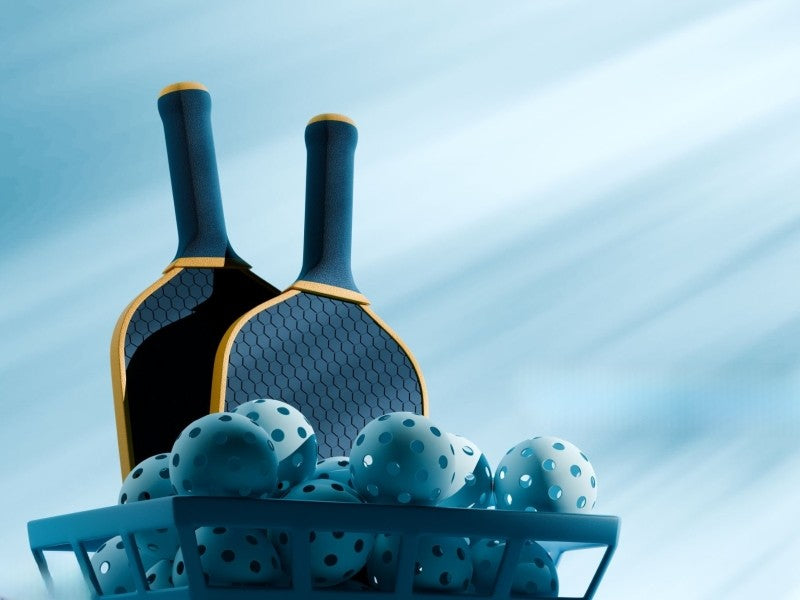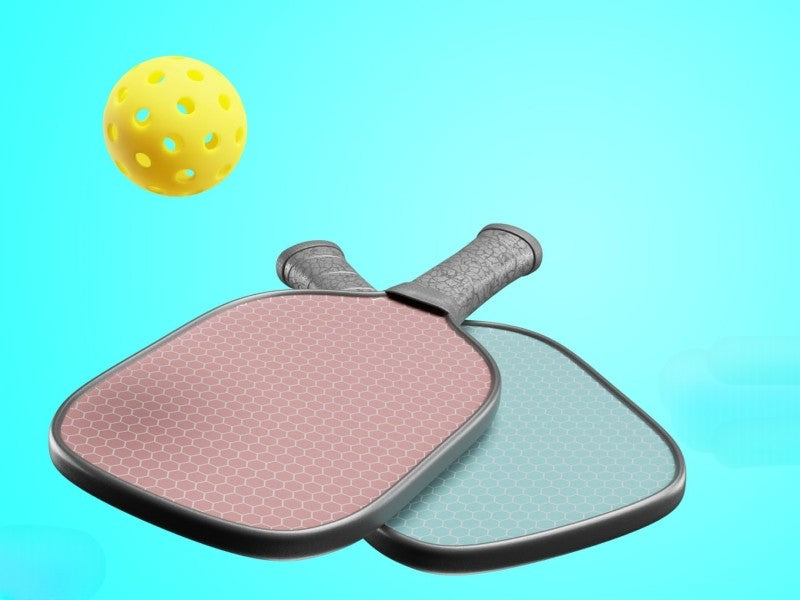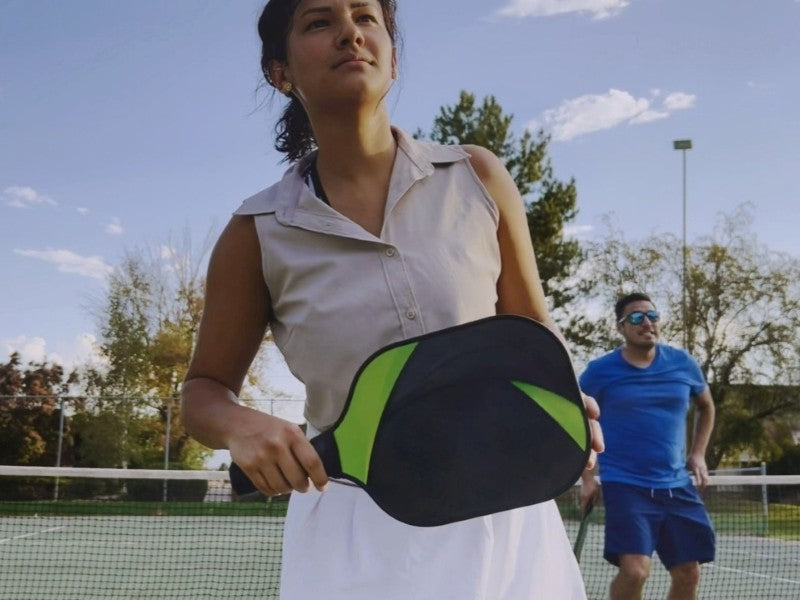1. Why Accessories Matter More for Pro Players
To casual players, pickleball accessories might seem optional — nice to have, but not essential. Yet for professionals and advanced competitors, these tools can make the difference between playing well and playing exceptionally.
Every detail counts at higher levels: grip comfort affects shot precision, recovery gear influences next-day performance, and even a small weight imbalance in footwear can shift reaction time. That’s why elite players treat their gear like a finely tuned system — every component, from the paddle to the post-match roller, has a purpose.
2. The Pro-Level Accessory List
Before we dive deep, here’s a snapshot of the accessories most often found in a pro player’s training and competition bag:
· Performance grips and overgrips
· Supportive wristbands and compression sleeves
· Stabilizing shoe insoles
· Resistance and agility bands
· Portable ball machines or rebounders
· Target markers for precision drills
· Data trackers or swing sensors
· Foam rollers and massage balls
· Cold/heat therapy wraps
· Edge guards and paddle protection tape
· Tournament-grade paddle bags
· Compression socks or sleeves for recovery
· Scoring tools and court organizers
Each item plays a small but significant role. Let’s explore how these accessories translate into real, measurable performance benefits on and off the court.
3. Performance-Enhancing Accessories — The Foundation of Consistency
3.1 Professional Grips and Overgrips
A player’s connection to the paddle is everything. Even the most advanced carbon-faced paddle loses control if your grip slips during play. That’s why pros often wrap their handles with performance overgrips that balance tackiness, sweat absorption, and thickness.
· Why it matters: Secure grip pressure ensures consistent shot angles and reduces wrist strain.
· What pros look for: High-friction polyurethane wraps with micro perforations for ventilation.
· Tip: Replace grips regularly — most players change them every 10–15 hours of play to maintain feel and hygiene.
Some pros use layered grips: a base wrap for cushioning and a thin overgrip for moisture control. It’s a low-cost upgrade that dramatically improves paddle control and reduces fatigue in long matches.
3.2 Wristbands and Support Sleeves
Extended rallies generate heat and tension through the forearm and wrist. Compression wristbands or elbow sleeves help maintain circulation and muscle alignment, reducing the risk of overuse injuries such as tennis elbow.
· Why it matters: Supports forearm stability during backhand drives and volleys.
· Pro insight: Top players use mild compression gear, not rigid braces, to allow free movement while maintaining blood flow.
· Bonus: Sweat-absorbent bands also prevent moisture from dripping onto paddle grips, a common cause of mid-match slippage.
3.3 Performance Insoles and Foot Stability
Footwork defines pickleball — fast lateral moves, quick stops, and sudden bursts forward. Generic shoe inserts rarely provide the necessary arch support and energy transfer.
Custom or sports-specific insoles absorb shock and distribute pressure evenly across the heel and forefoot.
· Benefits: Improved balance, faster push-offs, and less knee stress.
· Material to look for: Dual-density EVA or gel-polyurethane combinations.
· Pro tip: Rotate insoles between pairs and allow 24 hours of recovery time to maintain elasticity.
Injury prevention is a silent edge in professional play — consistent foot support translates to more stable pivots and fewer ankle rolls over long tournaments.
3.4 Agility and Resistance Bands
Off-court training tools like resistance bands and agility ladders are among the simplest yet most effective pickleball accessories. Top players use them to strengthen small stabilizer muscles and refine foot coordination.
· Why it matters: These tools simulate on-court motion and improve first-step explosiveness.
· Example drills:
o Lateral shuffle band walks to build glute strength.
o Quick ladder hops for reaction training.
o Resistance band swings to improve shoulder rotation control.
Professional trainers often integrate these into warm-ups — not to increase power, but to build movement efficiency and reduce injury risk during matches.
3.5 Eye Protection and Performance Glasses
Pickleball balls move faster than many realize — speeds can exceed 40 mph at pro levels. Eye protection isn’t just for safety; it enhances visibility under harsh lighting.
· Why it matters: Polarized or anti-fog lenses sharpen depth perception and minimize glare, especially under LED or sunlight.
· Preferred types: Lightweight polycarbonate frames with anti-slip arms.
· Pro note: Indoor players often prefer clear lenses; outdoor players use light-tinted UV filters.
A well-fitted pair of performance glasses can prevent strain and maintain focus during long games, particularly in doubles where net play is intense.

4. Training and Skill-Building Accessories
Even pros never stop drilling fundamentals. Behind every tournament victory are hundreds of hours of repetitive, structured training — often aided by accessories that allow solo practice and data-driven improvement.
4.1 Ball Machines and Rebound Nets
Portable ball machines and rebound nets allow players to simulate live rallies alone — perfect for refining consistency, footwork, and timing.
· Why pros use them:
o Maintain rhythm and precision without a hitting partner.
o Practice return-of-serve accuracy.
o Adjustable speed and spin options replicate real-match conditions.
For players on tighter budgets, rebound nets offer a compact alternative — ideal for backyard or driveway practice. They rebound shots at variable angles, helping train reflexes and shot preparation.
Training Tip: Alternate between volleys and soft-dink returns during solo sessions. This mimics mixed-pace rallies common in competitive doubles.
4.2 Target Markers and Precision Aids
To dominate at the net or baseline, pro players train their placement as much as their power. Target markers — flat rubber circles or adjustable cones — help them visualize accuracy zones.
· Purpose: Reinforces muscle memory for controlled shot depth and width.
· Pro method: Break court into zones (kitchen line, mid-court, back corner) and practice landing shots consistently.
· Added benefit: Builds visual focus, improving confidence during pressure points.
Precision aids are especially useful for coaching sessions or players analyzing technique with slow-motion video.
4.3 Data Trackers and Swing Analyzers
Modern players are embracing tech to refine performance. Swing sensors, shot counters, and wearable trackers provide insight into swing speed, contact consistency, and foot movement.
· Why it matters: Objective data helps correct inefficiencies invisible to the naked eye.
· Common metrics: Paddle angle at impact, backswing time, and step count per point.
· Best practice: Use tracking data sparingly — it complements, not replaces, feel-based training.
Many professional coaches now integrate motion analytics to customize training loads, preventing burnout and identifying optimal recovery windows.
4.4 Portable Nets and Training Court Kits
For players who travel or coach multiple groups, portable net systems are indispensable. They allow flexible setup in parking lots, gyms, or practice courts.
· Advantages:
o Enables consistent training environment anywhere.
o Facilitates warm-up drills before tournaments.
o Saves time in facility booking.
Pro players often carry compact nets that set up in under 5 minutes — allowing spontaneous practice wherever space allows. When paired with ball machines or targets, it becomes a complete mobile training setup.
4.5 Video Recording and Analysis Tools
Visual feedback accelerates progress. A simple phone tripod or gimbal, combined with slow-motion recording apps, allows players to review mechanics and shot patterns.
· Pro workflow: Record short 5–10 minute clips per session focusing on one technical aspect (e.g., backhand volley).
· Why it’s effective: Seeing movement errors helps correct habits faster than verbal cues alone.
· Advanced tip: Pair with swing sensors for synchronized motion data and visual review.
4.6 Training Bags and Organization Systems
Many pros treat their equipment bag like a mobile workstation. Dedicated training bags feature multiple compartments for paddles, hydration, recovery tools, and tech accessories.
· Reasoning: Easy access to each accessory saves time between drills and matches.
· Bonus: Helps track small items (bands, markers, wristbands) and prevents unnecessary wear.
· What to look for: Water-resistant materials, padded sections, and ventilated pockets.
The key idea: performance comes from preparation — and organization is a professional habit.
5. How to Choose the Right Pickleball Accessories for Your Game
Even though professional players rely on premium equipment, the key is finding accessories that fit your skill level, play style, and comfort. You don’t need to own the exact same products as pros, but you can apply their selection logic.
Here’s how to choose wisely:
1️. Prioritize Function Over Looks
A sleek paddle bag or colorful wristband might look good, but performance accessories should serve a purpose — better grip, enhanced control, or improved stability. Always ask: Does this improve my play or protect my body?
2️. Match Materials to Your Needs
For instance, a carbon-fiber paddle face increases power but can reduce touch feel for beginners. Similarly, high-tack grips give great control but may require frequent replacement. Understanding material behavior under game stress is critical for long-term satisfaction.
3️. Consider Your Playing Environment
Outdoor players face sun, wind, and dust. That means UV-resistant visors, anti-glare sunglasses, breathable shoes, and moisture-wicking clothing become essential. Indoor players, on the other hand, might prioritize traction and sweat absorption.
4️. Don’t Ignore Comfort
Accessories like padded gloves, ergonomic paddles, or soft socks prevent fatigue and blisters during long sessions. Professionals often customize their gear precisely for joint protection and muscle recovery, something recreational players can also benefit from.
6. Accessories That Help Prevent Injuries and Improve Longevity
Many players underestimate how small accessories can prevent chronic strain injuries. Pickleball is repetitive by nature, and overuse injuries are common among regular players.
1. Compression Sleeves and Elbow Braces
They help maintain blood flow and provide gentle joint support. Some pros wear lightweight compression sleeves during matches and thicker ones post-game for recovery.
2. Supportive Footwear and Insoles
A high-quality pair of pickleball shoes with good cushioning and arch support can drastically reduce knee and ankle strain. Professional players often use custom orthotic insoles to achieve perfect balance and weight distribution.
3. Hydration Accessories
Smart water bottles and electrolyte packs are often overlooked but vital. Even mild dehydration can reduce your reaction speed and concentration — a small but crucial difference in competitive play.
4. UV Protection Gear
Sun visors, cooling towels, and SPF-rated sleeves are essential for outdoor matches. Overexposure can lead to fatigue and skin irritation, so pros always have these on standby.
7. Building Your Own Pro-Inspired Pickleball Setup
Ready to upgrade? You can gradually build your kit based on what matters most to your game.
Step 1 – Start with the Essentials:
A quality paddle, a pair of court-specific shoes, and a durable paddle bag.
Step 2 – Add Functional Comfort:
Include moisture-absorbing wristbands, extra grips, and breathable sportswear.
Step 3 – Optimize for Performance:
Add compression sleeves, lightweight visors, or recovery tools like massage balls.
Step 4 – Personalize for Consistency:
Test multiple accessories to find your unique preferences — weight balance, grip size, or shoe fit can all affect shot consistency.









Leave a comment
This site is protected by hCaptcha and the hCaptcha Privacy Policy and Terms of Service apply.